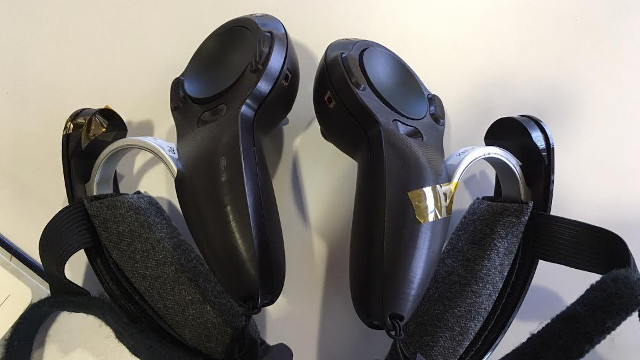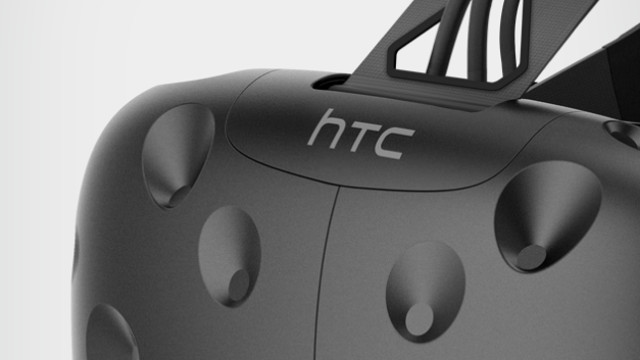Welcome to Part 3 of our Valve Interview Roundtable series. This week we had a chance to visit Valve’s headquarters in Bellevue, Washington to participate in a press interview roundtable where we spoke to several notable figures at the company, including founder Gabe Newell. In this multi-part series we will go over major talking points regarding software and the Steam platform.

- Part 1: Team Fortress 2
- Part 2: Counter-Strike: Global Offensive
- Part 3: Virtual Reality
- Part 4: Steam
After a brief intermission, several Valve developers reconvened for our next interview roundtable, this time focused on virtual reality. The discussion was led by DJ Powers, Joe Ludwig, Gabe Newell, Matt Brown, and Greg Coomer.
After brief introductions, Gabe Newell opened by asking a mysterious question. “Have you seen this controller before?”, he said before holding up two small, black motion controllers. These controllers happened to be the latest development iteration of the HTC Vive’s input devices.
The small form factor of the new controllers are a drastic change from what consumers are currently using, offering something that bears the appearance of an ergonomic Wii Nunchuk rather than a wand. Most of its design elements are the result of input from third-party developers, who Valve have established strong relationships with over the past two years.

Although appearing drastically different, the new HTC Vive controllers are more evolutionary than revolutionary. This also applies to the new Lighthouse sensors that Newell would pass around the room. These new base stations appear very similar to their original form, but inside there is one spinning rotor instead of two resulting in a “cheaper, smaller, less noisy, lower power solution”, said Joe Ludwig. “We think it will even track a little better and have a better field of view”.
Newell would then bring up Miyamoto, stating that he “thinks about what the input devices and system design should be like while trying to design games.” With HTC Vive, Valve is able to similarly work on hardware and software at the same time in an effort to “deliver better game experiences”. With this, it is constantly improving upon its hardware as software calls for it. Newell anticipates that some of the biggest improvements will be in display technology, which will include an increase in resolution and refresh rates at a rate faster than consumers might expect.
Valve voiced its interest in VR wireless technology, with Newell calling it a “solved problem at this point”. Considered an extraordinary development for the quality of the user experience—nobody likes tripping over cables while playing Budget Cuts—, Newell anticipates that it’ll arrive standalone in 2017, and could correspond with the second consumer version of the HTC Vive in 2018.
The sales performance of the HTC Vive has actually surpassed Valve’s admittedly modest expectations. Through development and continuing to today, Valve sees it as a valuable opportunity to push the industry forward, knowing that there’s a chance that it might fail altogether.
We’ve now begun seeing a transition toward a second generation of VR software. “People are now working on their second generation of games that incorporate everything that they learned and saw in the first generation of games,” said Newell. With this, Valve anticipates that we will see much more compelling software that “takes advantage of the unique characteristics of VR”.

On that note, Valve is developing VR games of its own. Newell confirmed that Valve is currently working on three VR titles that aren’t “experimental” like The Lab, but rather full experiences that will be announced in the future. Generally speaking, developers at Valve want to make big, substantial VR experiences, which many would argue is what it needs more than anything right now.
Following this, I asked whether software or pricing will be the deciding factor for VR’s adoption and success. Newell explained that he believes most people will not even consider investing in VR technology unless there are must-have games on the market, even if the HTC Vive were far less costly.
To conclude, I asked if there are any games that have surprised the team, Ludwig mentioned Blarp as a simple but very fun VR game. DJ Powers talked about a shooting game that he couldn’t name but sounded like Out of Ammo. Lastly, Brown shared that Climbey and Onward are two of his favorites.
It was clear during our discussion that the VR market will see extraordinary changes in the months ahead, with Valve playing a major role. This is only the beginning.
This concludes part 3 of our Valve Interview Roundtable series. In part 4 we will talk about the Steam platform and some interesting details we learned while speaking to Valve.







